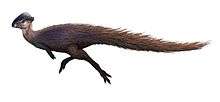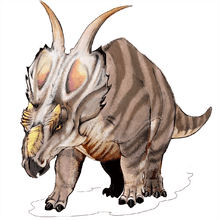Medusaceratops
| Medusaceratops Temporal range: Middle Campanian, 77.5 Ma | |
|---|---|
 | |
| Skeleton at Wyoming Dinosaur Museum formerly referred to Albertaceratops | |
| Scientific classification | |
| Kingdom: | Animalia |
| Phylum: | Chordata |
| Class: | Reptilia |
| Clade: | Dinosauria |
| Order: | †Ornithischia |
| Family: | †Ceratopsidae |
| Subfamily: | †Chasmosaurinae |
| Genus: | †Medusaceratops Ryan, Russell & Hartman, 2010 |
| Species: | †M. lokii |
| Binomial name | |
| Medusaceratops lokii Ryan, Russell & Hartman, 2010 | |
Medusaceratops is an extinct genus of chasmosaurine ceratopsian dinosaur known from the Late Cretaceous Judith River Formation (middle Campanian stage) of Montana, northern United States. It contains a single species, Medusaceratops lokii.[1]
Discovery

The known material of Medusaceratops came from a bonebed in the badlands on the west side of Kennedy Coulee adjacent to the Milk River, in the Milk River Natural Area, near Havre, Hill County of Montana. The material was first reported by Sweeney and Boyden (1993), who considered it to represent the southernmost occurrence of Styracosaurus albertensis, based on misidentified frill spikes. Trexler and Sweeney (1995) reinterpreted the spikes as eye-socket horncores and noted their similarity to those of the nomen dubium Ceratops montanus from a nearby area, however couldn't refer the bonebed material to any valid existing taxon. The bonebed, known as the Mansfield Bonebed honoring its landowner, is located on private land and historically has been excavated by several commercial companies. The type material of Medusaceratops and other specimens were excavated more recently and have been purchased by the Wyoming Dinosaur Center from Canada Fossils, Ltd., of Calgary, Alberta. Additional material from the same excavation was purchased and accessioned by the Royal Tyrrell Museum of Palaeontology. Canada Fossils, Ltd., also assembled two composite skeletons using the Mansfield Bonebed material which are in the collections of the Wyoming Dinosaur Center and the Fukui Prefectural Dinosaur Museum, however neither of the casts has an exact reconstruction of Medusaceratops as it was later described.[1]
The name "Medusaceratops" was coined by Canadian paleontologist Michael J. Ryan of the Cleveland Museum of Natural History in 2003 in a dissertation. Its fossils were confused with those of Albertaceratops, an unrelated centrosaurine ceratopsian from Alberta which had been described by Ryan in 2007. Later, Ryan realized that the Mansfield Bonebed fossils did not belong to Albertaceratops. Medusaceratops was formally described and name by Michael J. Ryan, Anthony P. Russell and Scott Hartman in 2010 and the type species is Medusaceratops lokii. The generic name refers to the Medusa, a monster in the Greek mythology whose "hair" consists of snakes and its gaze could turn men to stone, alluding to a unique trait of this genus - the large, thick snake-like spikes that extend to the sides of the frill, in combination with Latinized Greek ceratops, meaning "horned-face", which is a common suffix for ceratopsian genera names. The specific name lokii honors Loki, a troublemaking god in the Norse mythology, in reference to the years confusion that surrounded the taxonomic designations of the Mansfield Bonebed material before it was given its own name.[1]
The Mansfield Bonebed material was collected from the upper part of the Judith River Formation, in a region where it's lithologically equivalent to the Oldman Formation of Canada. The bonebed is located at approximately the same level as the holotype of Albertaceratops, dating to 77.5 million years ago, to the middle Campanian stage of the Late Cretaceous. Thus, Medusaceratops was considered to represent the oldest known chasmosaurine,[1] until the naming of Judiceratops by Longrich (2013), also from the Judith River Formation, but from an area equivalent to the lower Oldman Formation or upper Foremost Formation.[2]
Description

Two partial parietals (frills) that are housed at the Wyoming Dinosaur Center were chosen as the type material of Medusaceratops, including the holotype WDC DJR 001 and the paratype WDC DJR 002. Although all the chasmosaurine material from the Mansfield Bonebed is thought to be referable to Medusaceratops, which totals at several hundred individual elements, only these two partial frills have been scientifically described while the rest of the material is being reexamined by Ryan. Many of the other elements are not diagnosibale to a genus level and can be only confidently referable to Chasmosaurinae.[1]
When considering only its type material, Medusaceratops is unique among Chasmosaurinae in having only three epi-parietals (frill spikes) on each half of the frill. The first frill spike pair is large and the second is smaller, and both are uniquely widened at base, pachyostotic, curve down the sides of the frill, and are depressed down the front of the frill. The third frill spike pair is small and triangular, unmodified in comparison to other early chasmosaurine, but similarly depressed, and is bordering to the squamosal bone. The highly broadened and curved first frill spike pair of Medusaceratops closely resembles the third pair of the frill ornamentation of Albertaceratops, however Medusaceratops (and all chasmosaurines) differs in lacking tab-shaped, frequently overlapping fourth to seventh pairs of the frill ornamentation of centrosaurines.[1]
Among other valid chasmosaurines from the Judith River Formation, Medusaceratops can be directly distinguished from Judiceratops and Spiclypeus based on its unique frill ornamentation,[3] and from Mercuriceratops based on lacking its unique squamosal bone shape[4] based on undescribed elements of Medusaceratops (which include the squamosal).[1]
See also
References
- 1 2 3 4 5 6 7 Ryan, Michael J.; Russell, Anthony P., and Hartman, Scott. (2010). "A New Chasmosaurine Ceratopsid from the Judith River Formation, Montana", In: Michael J. Ryan, Brenda J. Chinnery-Allgeier, and David A. Eberth (eds), New Perspectives on Horned Dinosaurs: The Royal Tyrrell Museum Ceratopsian Symposium, Indiana University Press, 656 pp. ISBN 0-253-35358-0.
- ↑ Longrich, N. R. (2013). "Judiceratops tigris, a New Horned Dinosaur from the Middle Campanian Judith River Formation of Montana". Bulletin of the Peabody Museum of Natural History. 54: 51–65. doi:10.3374/014.054.0103.
- ↑ Jordan C. Mallon, Christopher J. Ott, Peter L. Larson, Edward M. Iuliano and David C. Evans (2016). "Spiclypeus shipporum gen. et sp. nov., a Boldly Audacious New Chasmosaurine Ceratopsid (Dinosauria: Ornithischia) from the Judith River Formation (Upper Cretaceous: Campanian) of Montana, USA". PLoS ONE. 11 (5): e0154218. doi:10.1371/journal.pone.0154218.
- ↑ Ryan, M. J.; Evans, D. C.; Currie, P. J.; Loewen, M. A. (2014). "A new chasmosaurine from northern Laramidia expands frill disparity in ceratopsid dinosaurs". Naturwissenschaften. doi:10.1007/s00114-014-1183-1.


